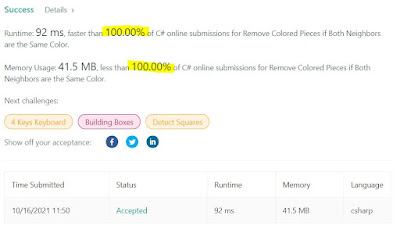Usually in "gaming" coding problems, don't simulate the game
Gaming coding problems can always be solved thru the simulation of the game, but that usually leads to TLE (Time Limit Exceeded). Instead, it is better to found the conditions in which player A would win, and perform an algorithm (usually linear) to see if the condition can be met at the end.
In the case of the problem below, the condition would be the following: as long as player A has more available moves than player B, player A would win. Write a function in linear time to determine the number of available moves given a player. That can be done in linear time. Code is below, cheers, ACC.
2038. Remove Colored Pieces if Both Neighbors are the Same Color
Medium
There are n pieces arranged in a line, and each piece is colored either by 'A' or by 'B'. You are given a string colors of length n where colors[i] is the color of the ith piece.
Alice and Bob are playing a game where they take alternating turns removing pieces from the line. In this game, Alice moves first.
- Alice is only allowed to remove a piece colored
'A'if both its neighbors are also colored'A'. She is not allowed to remove pieces that are colored'B'. - Bob is only allowed to remove a piece colored
'B'if both its neighbors are also colored'B'. He is not allowed to remove pieces that are colored'A'. - Alice and Bob cannot remove pieces from the edge of the line.
- If a player cannot make a move on their turn, that player loses and the other player wins.
Assuming Alice and Bob play optimally, return true if Alice wins, or return false if Bob wins.
Example 1:
Input: colors = "AAABABB" Output: true Explanation: AAABABB -> AABABB Alice moves first. She removes the second 'A' from the left since that is the only 'A' whose neighbors are both 'A'. Now it's Bob's turn. Bob cannot make a move on his turn since there are no 'B's whose neighbors are both 'B'. Thus, Alice wins, so return true.
Example 2:
Input: colors = "AA" Output: false Explanation: Alice has her turn first. There are only two 'A's and both are on the edge of the line, so she cannot move on her turn. Thus, Bob wins, so return false.
Example 3:
Input: colors = "ABBBBBBBAAA" Output: false Explanation: ABBBBBBBAAA -> ABBBBBBBAA Alice moves first. Her only option is to remove the second to last 'A' from the right. ABBBBBBBAA -> ABBBBBBAA Next is Bob's turn. He has many options for which 'B' piece to remove. He can pick any. On Alice's second turn, she has no more pieces that she can remove. Thus, Bob wins, so return false.
Constraints:
1 <= colors.length <= 105colorsconsists of only the letters'A'and'B'
public bool WinnerOfGame(string colors)
{
return CountPossibleMoves(colors, 'A') > CountPossibleMoves(colors, 'B');
}
public int CountPossibleMoves(string colors, char color)
{
int retVal = 0;
int countConsecutive = 0;
for (int i = 0; i < colors.Length; i++)
{
if (colors[i] == color && (i > 0 && colors[i] == colors[i - 1]))
{
countConsecutive++;
if (countConsecutive >= 3)
{
retVal++;
}
}
else if (colors[i] == color)
{
countConsecutive = 1;
}
else
{
countConsecutive = 0;
}
}
return retVal;
}



Comments
Post a Comment